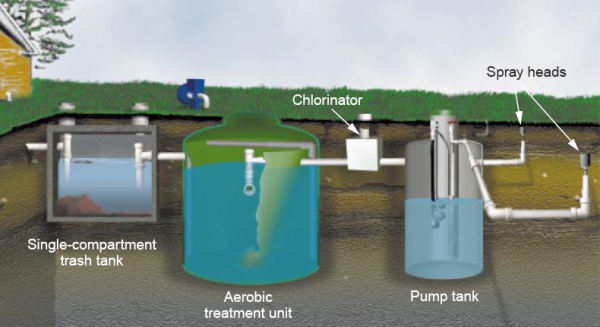
Around 33% of Americans have a septic tank treating the waste in their homes. By design, these septic tanks are realtively simple and straightforward. All plumbing lines in the home meet to a solitary pipe that exits the home and enters the septic tank covered outside. At the point when the waste water from your toilet, shower, sinks and clothes washer go out, it’s joined. When it hits the septic tank, nonetheless, it starts to isolate. The heaviest particulate issue in the waste, called sludge, sinks to the base. At the highest point of the tank, fats, oils and proteins structure the gliding filth layer. In the center is the relatively clear fluid layer called efluent or gray water. Consolidated, these segments are called sludge.
Septic systems are are laid out so just the gray water is released from the tank into the channel field (likewise called the drain field). This is basically a pipe with many holes bored into them that discharge the gray water subterranean (however over the water table). The emanating is sufficiently corrupted to be well-filtered by great soil. There’s a lot of natural material left in the emanating, however, which goes about as manure. This is the reason the channel field as a rule brags the most advantageous section the yard above it.
Even though septic tanks are simple, they require some upkeep and inspections to keep them running right. Ordinarily, when your toilets stop flushing it obvious that you have a septic issue. Fixing huge septic issues can be expensive costing thousands of dollars. Luckily, a little support can go far in evading issues.
Indeed, even with a solid microbial biological system separating the septage, a well-working septic tank and drain field, the sludge layer in your tank will develop after some time. These solids will need to be pumped out occasionally (about every couple years) – for the most part when the base of the gliding rubbish layer is within 6 inches of the outlet pipe or the highest point of the compresses sludge layer is around 12 inches.
Keeping your septic system operating correctly is important and why it’s recommended to get inspected annually. Having your system inspected means getting your tank pumped and cleaned many times. The normal septic tank ordinarily requires getting pumped each one to three years.

Without normal siphoning of the septic tank, the septic tank can fill up and stop up. Once in a while flood can lead back to the house, where toilets and drains get filled with what should be out in the septic tank. A flood can likewise prompt an abrupt downpour of natural waste flooding the drain field. At the point when this occurs, water can leak over the ground, which prompts an overflowed yard and run-off into adjacent water bodies like rivulets and waterways. Subterranean, this flood can create additional harm, spoiling groundwater. Together, these interruptions of waste can taint the water individuals use and drink. The waste brought into the water supply can convey unsafe microscopic organisms and diseases like hepatitis.
Any area that you find a bunch of homes using septic tanks you will also find plenty of septic companies that offer service. This is a significant administration; if an excess of sludge develops after some time, it can prompt flood, which is terrible for everyone.
For the most part, business septic siphoning includes a siphon truck expelling the sludge, and rubbish in the tank and leaving the tank unfilled and prepared to be filled once more. When the waste is expelled, there are just such huge numbers of things that should be possible with it. Before government laws that limit septic ooze dumping, squander organizations could basically cover it in dump locales. As it turned out to be evident that locales like these were a wellbeing risk, they were banned. These destinations remain, however many are presently remediation (tidy up).
Nowadays, government and state laws administer the last goal of the substance of your septic tank. Now and again, the septic substance is taken to squander treatment plants and added to the stew funneled in from a city sewer framework or conveyed to free, revenue driven organizations work in the treatment of septage. Septage might be treated in cesspools, which hold the waste while concoction or natural materials separate it into emanating. Septage may likewise be dumped in affirmed landfills. The rules concerning septage dumping are exacting and locales can be rare, be that as it may.